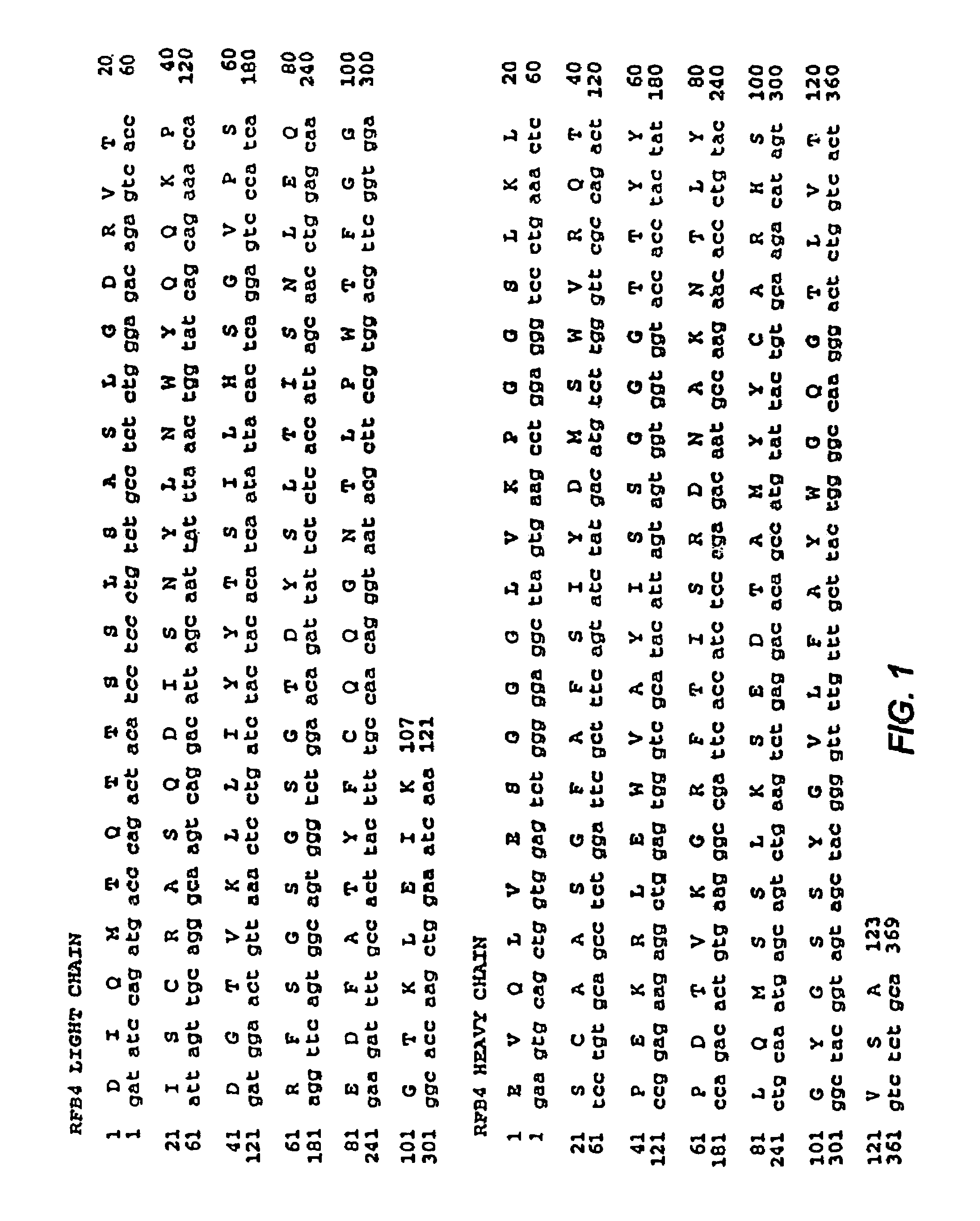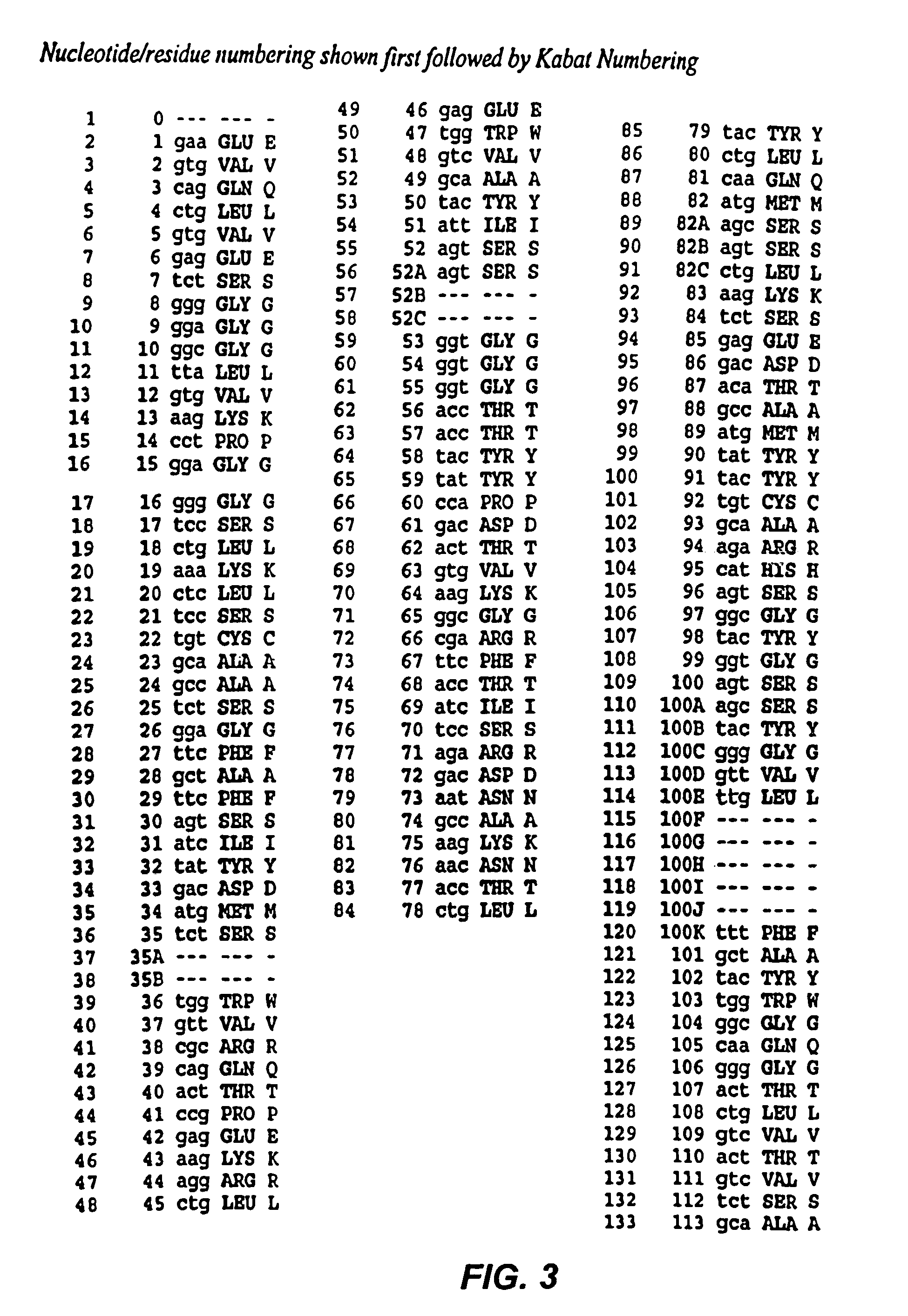Mutated anti-CD22 antibodies with increased affinity to CD22-expressing leukemia cells
a technology of cd22 and anticd22, which is applied in the field of mutated anticd22 antibodies with increased affinity to cd22-expressing leukemia cells, can solve the problems of inability to induce long-term complete remission of conventional therapies, the inability of most people to obtain atomic resolution structural data, and the large public health problem of hematological malignancies
- Summary
- Abstract
- Description
- Claims
- Application Information
AI Technical Summary
Benefits of technology
Problems solved by technology
Method used
Image
Examples
example 1
[0154]The experiments reported in this example demonstrate the creation and use of of phage display libraries to select RFB4-Fvs that bind the CD22 antigen of Daudi cells with increased affinity over the wild type RBF4-Fv.
[0155]The CDR3 of the variable heavy chain (VH) of RFB4 (Fv) was mutated in an attempt to create Fvs with increased antigen binding affinity. The wild type amino acid sequence of VHCDR3 of RFB4 (Fv) contains 14 amino acids, as shown below in Table 1.
[0156]
TABLE 1DNA and amino acid sequences of CDR3 heavy chain RFB495 96 97 98 99 100 100A 100B 100C 100D 100E 100F 101 102 H S G Y G S S Y G V L F A YCAT AGT GGC TAC GGT AGT AGC TAC GGG GTT TTG TTT GCT TAC —————— —————
[0157]The mutational hot spots in VH CDR3 of RFB4 are underlined in the Table. A selected subgroup of the hotspots was targeted for mutagenesis: G99 (GGT), S100 (AGT), S100A (AGC), and Y100B (TAC) were randomly mutated and a ...
example 2
[0174]The studies reported in this Example demonstrate that incorporation of the mutant scFvs selected in Example 1 into the structure of a chimeric immunotoxin molecule increases the cytotoxic activity of the chimeric immunotoxins toward cultured cells that display the CD22 antigen, thereby inhibiting growth of the cultures.
[0175]Immunotoxins from each of the three major 100B substitutions GTTW (SEQ ID NO:16), GYNW (SEQ ID NO:15), GTHW (SEQ ID NO:14), GSTY (SEQ ID NO:17), and GKNR (SEQ ID NO:18) were prepared. ScFvs from selected phagemids were PCR amplified using primers that introduced Nde I and HindIII restrictions sites into the final PCR product. The products of the reaction were purified, digested with Nde I and HindIII and cloned into a T7 expression vector in which the scFv was fused in frame to a truncated version of Pseudomonas exotoxin A (PE38) (Brinkmann, U., Mol. Med Today, 2:439-446 (1996)). The expression and purification of the resulting recombinant immunotoxins was...
example 3
[0182]The studies reported in this Example demonstrate that the mutant RFB4-PE38 immunotoxins of Example 2 are more effective at inhibiting the growth of malignant cells taken from patients with advanced lymphocytic disease than is the chimeric immunotoxin bearing the wild-type VHCDR3 of RFB4, RFB4-PE38.
[0183]Cytotoxic activity of mutant immunotoxins on malignant cells isolated from patients was measured in blood samples collected from patients as part of approved clinical protocols at the NIH. Patients 1, 2, 3, and 5 have chronic lymphocytic leukemia (CLL). Patient 4 has hairy cell leukemia (HCL). Samples were processed as previously described (Kreitman, R. J. et al., Clin. Cancer Res., 6:1476-1487 (2000)). Briefly, protein synthesis was measured by counting cpm of [3H] leucine incorporated into protein. Inhibition of protein synthesis of 50%, defined as being halfway between the level of incorporation of 3[H] leucine in the absence of toxin and the level of incorporation of 3[H] l...
PUM
| Property | Measurement | Unit |
|---|---|---|
| average bond energy | aaaaa | aaaaa |
| temperature | aaaaa | aaaaa |
| temperature | aaaaa | aaaaa |
Abstract
Description
Claims
Application Information
 Login to View More
Login to View More - R&D
- Intellectual Property
- Life Sciences
- Materials
- Tech Scout
- Unparalleled Data Quality
- Higher Quality Content
- 60% Fewer Hallucinations
Browse by: Latest US Patents, China's latest patents, Technical Efficacy Thesaurus, Application Domain, Technology Topic, Popular Technical Reports.
© 2025 PatSnap. All rights reserved.Legal|Privacy policy|Modern Slavery Act Transparency Statement|Sitemap|About US| Contact US: help@patsnap.com



